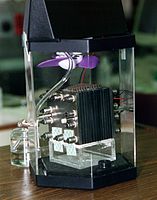
Photo from wikipedia
Protonic ceramic fuel cells (PCFCs) are expected to achieve high power generation efficiency at intermediate temperature around 400–600 °C. In the present work, the distribution of relaxation times (DRT) analysis… Click to show full abstract
Protonic ceramic fuel cells (PCFCs) are expected to achieve high power generation efficiency at intermediate temperature around 400–600 °C. In the present work, the distribution of relaxation times (DRT) analysis was investigated in order to deconvolute the anode and cathode polarization resistances for PCFCs supported on yttria-doped barium cerate (BCY) electrolyte in comparison with solid oxide fuel cells (SOFCs) supported on scandia-stabilized zirconia (ScSZ) electrolyte. Four DRT peaks were detected from the impedance spectra measured at 700 °C excluding the gas diffusion process for ScSZ and BCY. The DRT peaks at 5 × 102–1 × 104 Hz and 1 × 100–2 × 102 Hz were related to the hydrogen oxidation reaction at the anode and the oxygen reduction reaction at the cathode, respectively, for both cells. The DRT peak at 2 × 101–1 × 103 Hz depended on the hydrogen concentration at the anode for ScSZ, while it was dependent on the oxygen concentration at the cathode for BCY. Compared to ScSZ, steam was produced at the opposite electrode in the case of BCY, which enhanced the cathode polarization resistance for PCFCs.
Journal Title: Scientific Reports
Year Published: 2021
Link to full text (if available)
Share on Social Media: Sign Up to like & get
recommendations!